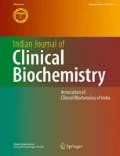Abstract
The aim of this study was to monitor serum nitric oxide levels at various times, intraoperatively and following liver transplantation in humans. Nitric oxide production was assessed by cadmium reduction method in 15 patients undergoing liver transplantation. We observed strong correlation between nitric oxide production and allograft rejection. Sustained rise in nitric oxide level after transplantation might provide an indication of acute allograft rejection. Therefore measurement of nitric oxide, a stable end product appears to be an excellent marker that can help in the development of strategies intended to improve graft viability and patient’s survival.
References
Lemasters J, Bunzendahl H, Thurman R. Reperfusion injury to donor livers stored for transplantation. Liver Transplantation 1995; 1:124–138.
Zi-Qing H, He-Qing H, Chen-Fang L, Shang-Rong L, Gang-Jian L. Changes of Nitric Oxide & endothelin, thromboxane A2 and prostaglandin in cirrhotic patients undergoing liver transplantation. World J Gastroenterol 2006; 7:12(25): 4049–4051.
Vijay S, Patrick SK. Nitric oxide in liver transplantation: Pathobiology and clinical implications. Liver Transplantation 2003; 9(1):1–11.
Kuo PC, Alfrey EJ, Abe K, Huie P, Sibley RK, Dafoe DC. Cellular localization & effect of nitric oxide synthesis in a rat model of orthotopic liver transplantation. Transplantation 1996;61:305–12
Ioannidis I, Hellinger A, Dehmlow C, Rauen U, Erhard J, Eigler FW, et al. Evidence for increased nitric oxide production after liver transplantation in humans. Transplant 1995;59:1293–1297.
Devlin J, Palmer RM, Gonde CE, O’Grady J, Heaton N, Tan KC, et al. Nitric oxide generation- a predictive parameter of acute allograft rejection. Transplant 1994; 58:592–595.
Cortas NK, Wakid NW. Determination of inorganic nitrate in serum & urine by a kinetic cadmium reduction method. Clin Chem 1990; 3618:1440–1443.
Battista S, Mengozzi G, Bar F, Cerutti E, Pollet C, Torchio M, et al. Nitric oxide level profile in human liver transplantation. Digestive Diseases and Sciences 2002; 47(3):528–534.
Peralta C, Hotter G, Closa D, Gelpi E, Bulbena O, Rosello-Catafau J, et al. Protective effect of preconditioning on the injury associated to hepatic ischemia-reperfusion in the rat: Role of nitric oxide and adenosine. Hepatology 1997; 25: 934–937.
Esteban F, Gomez-Jimenez J, Martin MC, Ruiz JC, Nuvials X, Garcia-Allut JL, et al. Nitric oxide & hepatic ischemic injury in human orthotopic liver transplantation. Transplant Proc 1995; 27:2283–2285.
Palmer RMJ, Bridge L, Foxwell NA, Moncada S. The role of nitric oxide in endothelial cell damage and it’s inhibition by glucocorticoids. Brit J Pharmacol 1992; 105:575.
Curran RD, Ferrari FK, Kispert PH. Nitric oxide and nitric oxide generating compounds inhibit hepatocyte protein synthesis. FASEB J 1991; 5:2085.
Author information
Authors and Affiliations
Corresponding author
Rights and permissions
About this article
Cite this article
Thorat, V.N., Suryakar, A.N., Nailk, P. et al. Nitric oxide: A useful indicator in acute allograft rejection after liver transplantation. Indian J Clin Biochem 24, 105–107 (2009). https://doi.org/10.1007/s12291-009-0019-9
Published:
Issue Date:
DOI: https://doi.org/10.1007/s12291-009-0019-9

